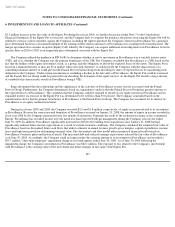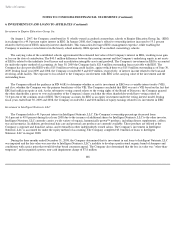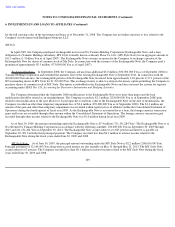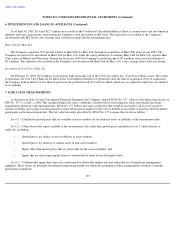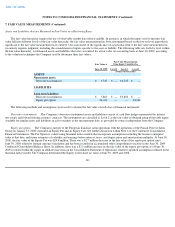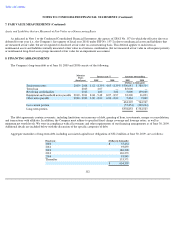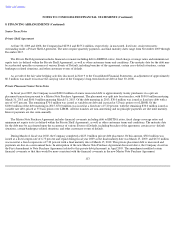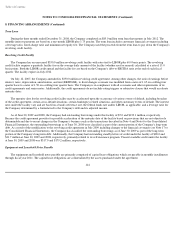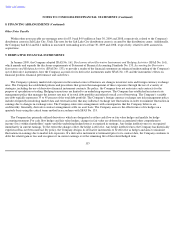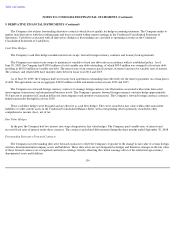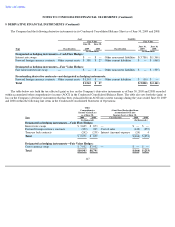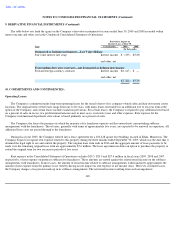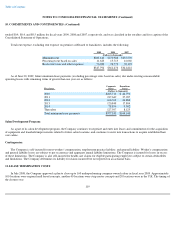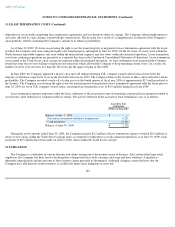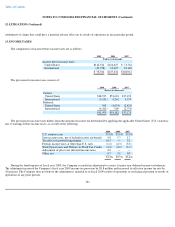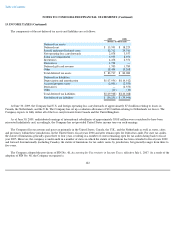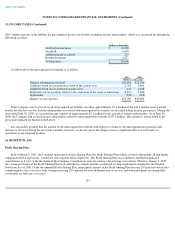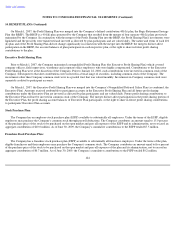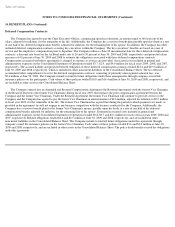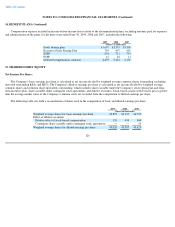Supercuts 2009 Annual Report Download - page 118
Download and view the complete annual report
Please find page 118 of the 2009 Supercuts annual report below. You can navigate through the pages in the report by either clicking on the pages listed below, or by using the keyword search tool below to find specific information within the annual report.
Table of Contents
NOTES TO CONSOLIDATED FINANCIAL STATEMENTS (Continued)
9. DERIVATIVE FINANCIAL INSTRUMENTS (Continued)
The Company also utilizes freestanding derivative contracts which do not qualify for hedge accounting treatment. The Company marks to
market such derivatives with the resulting gains and losses recorded within current earnings in the Condensed Consolidated Statement of
Operations. Cash flows associated with all derivatives (hedges or freestanding) are classified as operating activities in the Condensed
Consolidated Statement of Cash Flows.
Cash Flow Hedges
The Company's cash flow hedges include interest rate swaps, forward foreign currency contracts and treasury lock agreements.
The Company uses interest rate swaps to maintain its variable to fixed rate debt ratio in accordance with its established policy. As of
June 30, 2009, the Company had $190.0 million of total variable rate debt outstanding, of which $90.0 million was swapped to fixed rate debt,
resulting in $100.0 million of variable rate debt. The interest rate swap contracts pay fixed rates of interest and receive variable rates of interest.
The contracts and related debt have maturity dates between fiscal year 2012 and 2015.
As of June 30, 2009, the Company had two treasury lock agreements outstanding that effectively fix the interest payments on certain pieces
of debt. The agreements are on an aggregate $100.0 million of debt and mature in fiscal years 2013 and 2015.
The Company uses forward foreign currency contracts to manage foreign currency rate fluctuations associated with certain forecasted
intercompany transactions and international business travel. The Company's primary forward foreign currency contracts hedge approximately
50.0 percent of payments in Canadian dollars for intercompany retail inventory transactions. The Company's forward foreign currency contracts
hedge transactions through fiscal year 2010.
These cash flow hedges were designed and are effective as cash flow hedges. They were recorded at fair value within other noncurrent
liabilities or other current assets in the Condensed Consolidated Balance Sheet, with corresponding offsets primarily recorded in other
comprehensive income (loss), net of tax.
Fair Value Hedges
In the past, the Company had two interest rate swaps designated as fair value hedges. The Company paid variable rates of interest and
received fixed rates of interest under these contracts. The contracts and related debt matured during the three months ended September 30, 2008.
Freestanding Derivative Forward Contracts
The Company uses freestanding derivative forward contracts to offset the Company's exposure to the change in fair value of certain foreign
currency denominated intercompany assets and liabilities. These derivatives are not designated as hedges and therefore, changes in the fair value
of these forward contracts are recognized currently in earnings, thereby offsetting the current earnings effect of the related foreign currency
denominated assets and liabilities.
116



